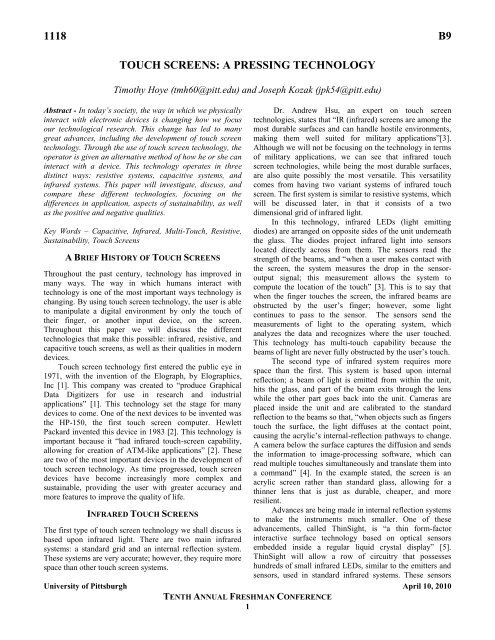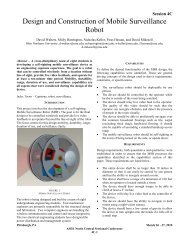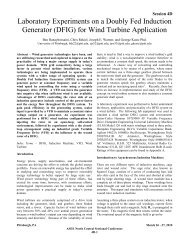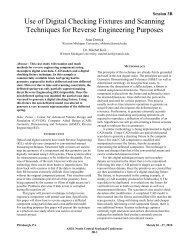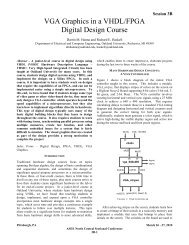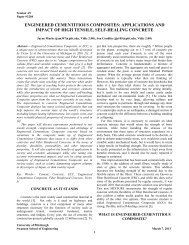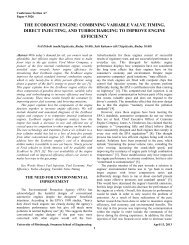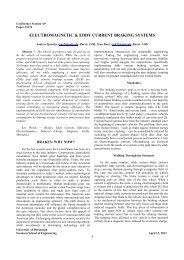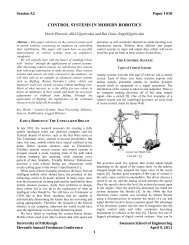Create successful ePaper yourself
Turn your PDF publications into a flip-book with our unique Google optimized e-Paper software.
1118 B9<br />
TOUCH SCREENS: A PRESSING TECHNOLOGY<br />
Timothy Hoye (tmh60@pitt.edu) and Joseph Kozak (jpk54@pitt.edu)<br />
Abstract - In today’s society, the way in which we physically<br />
interact with electronic devices is changing how we focus<br />
our technological research. This change has led to many<br />
great advances, including the development of touch screen<br />
technology. Through the use of touch screen technology, the<br />
operator is given an alternative method of how he or she can<br />
interact with a device. This technology operates in three<br />
distinct ways: resistive systems, capacitive systems, and<br />
infrared systems. This paper will investigate, discuss, and<br />
compare these different technologies, focusing on the<br />
differences in application, aspects of sustainability, as well<br />
as the positive and negative qualities.<br />
Key Words – Capacitive, Infrared, Multi-<strong>Touch</strong>, Resistive,<br />
Sustainability, <strong>Touch</strong> <strong>Screens</strong><br />
A BRIEF HISTORY OF TOUCH SCREENS<br />
Throughout the past century, technology has improved in<br />
many ways. The way in which humans interact with<br />
technology is one of the most important ways technology is<br />
changing. By using touch screen technology, the user is able<br />
to manipulate a digital environment by only the touch of<br />
their finger, or another input device, on the screen.<br />
Throughout this paper we will discuss the different<br />
technologies that make this possible: infrared, resistive, and<br />
capacitive touch screens, as well as their qualities in modern<br />
devices.<br />
<strong>Touch</strong> screen technology first entered the public eye in<br />
1971, with the invention of the Elograph, by Elographics,<br />
Inc [1]. This company was created to “produce Graphical<br />
Data Digitizers for use in research and industrial<br />
applications” [1]. This technology set the stage for many<br />
devices to come. One of the next devices to be invented was<br />
the HP-150, the first touch screen computer. Hewlett<br />
Packard invented this device in 1983 [2]. This technology is<br />
important because it “had infrared touch-screen capability,<br />
allowing for creation of ATM-like applications” [2]. These<br />
are two of the most important devices in the development of<br />
touch screen technology. As time progressed, touch screen<br />
devices have become increasingly more complex and<br />
sustainable, providing the user with greater accuracy and<br />
more features to improve the quality of life.<br />
INFRARED TOUCH SCREENS<br />
The first type of touch screen technology we shall discuss is<br />
based upon infrared light. There are two main infrared<br />
systems: a standard grid and an internal reflection system.<br />
These systems are very accurate; however, they require more<br />
space than other touch screen systems.<br />
Dr. Andrew Hsu, an expert on touch screen<br />
technologies, states that “IR (infrared) screens are among the<br />
most durable surfaces and can handle hostile environments,<br />
making them well suited for military applications”[3].<br />
Although we will not be focusing on the technology in terms<br />
of military applications, we can see that infrared touch<br />
screen technologies, while being the most durable surfaces,<br />
are also quite possibly the most versatile. This versatility<br />
comes from having two variant systems of infrared touch<br />
screen. The first system is similar to resistive systems, which<br />
will be discussed later, in that it consists of a two<br />
dimensional grid of infrared light.<br />
In this technology, infrared LEDs (light emitting<br />
diodes) are arranged on opposite sides of the unit underneath<br />
the glass. The diodes project infrared light into sensors<br />
located directly across from them. The sensors read the<br />
strength of the beams, and “when a user makes contact with<br />
the screen, the system measures the drop in the sensoroutput<br />
signal; this measurement allows the system to<br />
compute the location of the touch” [3]. This is to say that<br />
when the finger touches the screen, the infrared beams are<br />
obstructed by the user’s finger; however, some light<br />
continues to pass to the sensor. The sensors send the<br />
measurements of light to the operating system, which<br />
analyzes the data and recognizes where the user touched.<br />
This technology has multi-touch capability because the<br />
beams of light are never fully obstructed by the user’s touch.<br />
The second type of infrared system requires more<br />
space than the first. This system is based upon internal<br />
reflection; a beam of light is emitted from within the unit,<br />
hits the glass, and part of the beam exits through the lens<br />
while the other part goes back into the unit. Cameras are<br />
placed inside the unit and are calibrated to the standard<br />
reflection to the beams so that, “when objects such as fingers<br />
touch the surface, the light diffuses at the contact point,<br />
causing the acrylic’s internal-reflection pathways to change.<br />
A camera below the surface captures the diffusion and sends<br />
the information to image-processing software, which can<br />
read multiple touches simultaneously and translate them into<br />
a command” [4]. In the example stated, the screen is an<br />
acrylic screen rather than standard glass, allowing for a<br />
thinner lens that is just as durable, cheaper, and more<br />
resilient.<br />
Advances are being made in internal reflection systems<br />
to make the instruments much smaller. One of these<br />
advancements, called ThinSight, is “a thin form-factor<br />
interactive surface technology based on optical sensors<br />
embedded inside a regular liquid crystal display” [5].<br />
ThinSight will allow a row of circuitry that possesses<br />
hundreds of small infrared LEDs, similar to the emitters and<br />
sensors, used in standard infrared systems. These sensors<br />
University of Pittsburgh April 10, 2010<br />
TENTH ANNUAL FRESHMAN CONFERENCE<br />
1
1118 B9<br />
and emitters are much smaller and would cover a much<br />
smaller area of the screen. Traditional internal reflection<br />
system only required four or five emitters and cameras.<br />
Thinsight technology is still in development; however, it is<br />
believed that these advancements could make infrared touch<br />
screen technology much smaller. The advancements would<br />
also cause the system to be more available for future<br />
consumer touch screen devices.<br />
FIGURE 1<br />
THINSIGHT TOUCH SCREEN INFRARED EMITTERS AND DETECTORS [5]<br />
Microsoft Surface<br />
As mentioned above, the Microsoft Surface is a great<br />
example of internal reflection infrared touch screens. In<br />
early 2001, “Steve Bathiche of Microsoft Hardware and<br />
Andy Wilson of Microsoft Research began brainstorming<br />
concepts for an interactive table”, beginning the<br />
development of the Surface [6]. The process continued in<br />
development until 2003 when the idea was presented to Bill<br />
Gates, and 85 prototypes were created for developers on the<br />
Surface Computing group, a group created in 2004 to solely<br />
develop the Surface. In 2005, various prototypes were<br />
created and analyzed, and eventually, in 2008, the Microsoft<br />
Surface was on sale to the public for $12,500 or $15,000 [6].<br />
The Surface’s “technology uses multiple image sensors<br />
around one side of the touch surface and IR backlights on<br />
the other side. When a user places his finger on the surface,<br />
intercepting the infrared beam, the device projects a shadow.<br />
Using multiple cameras, the unit converts this shadow into a<br />
touch point through triangulation” [3]. As stated by Dr. Hsu,<br />
the Surface uses a system of cameras and IR LED’s to<br />
capture the image of the object touching the surface. The<br />
Surface took a step forward with their technology,<br />
developing a special motherboard to compute the data,<br />
transmitted at 100 megabytes per second, from the cameras.<br />
The board then divides the data into sections that decide<br />
what is relevant and what is not. Relevant data is considered<br />
to be any information from the cameras that has changed<br />
since the last transmission. An example of that is the shadow<br />
from the infrared light changing as someone touches the<br />
screen.<br />
This software is also revolutionary in that it detects and<br />
distinguishes different types of touches. The Surface<br />
categorizes touches into three sets: finger, blob, and tagged<br />
objects. Fingers are given the ability to click on software<br />
application buttons, paint across the screen, and further<br />
interact with the Surface. Blobs are generic objects that are<br />
given a circular or oval reading with a major and minor axis.<br />
Blobs include inanimate objects like paper or other pieces of<br />
technology like smart phones or cameras [7]. Microsoft<br />
products, like the Microsoft Zune music player, can interact<br />
with the Surface just by laying Zune upon the top of the<br />
screen. Multiple Zunes can interact with one another using<br />
the Surface as an intermediary, transferring songs from one<br />
to another. Cameras and phones can also perform similar<br />
tasks with contacts, pictures, maps, and many other pieces of<br />
data. Microsoft has been “initially selling Surface to<br />
Starwood Hotels for guest check in, Harrah’s Entertainment<br />
for video gambling, and T-Mobile for providing customers<br />
with technical information about the company’s mobile<br />
phones” [4]. The Surface allows for the use of tagged items,<br />
specific to where the device is located. Tagged items could<br />
include gambling chips at a Harrah’s Casino or an electric<br />
keycard at a Starwood Hotel. The tagged items give the<br />
Surface very specific data, which includes the facing<br />
direction of the object as well as electric data on the tagged<br />
item itself [7].<br />
FIGURE 2<br />
MICROSOFT SURFACE [6]<br />
Through previous advances in touch screen<br />
technology, Microsoft took a step forward in infrared<br />
systems with their Surface. The Surface’s starting price is<br />
$12,500. This high cost makes the Surface inaccessible to<br />
personal consumers, and is therefore marketed toward<br />
corporations or companies.<br />
RESISTIVE TOUCH SCREENS<br />
Resistive touch screen systems are the most common type of<br />
touch screen technology in today’s market. These devices<br />
are used in many applications, such as cell phones, handheld<br />
games, GPS navigation devices, and even some digital<br />
cameras [3].<br />
The resistive touch screen technology operates in a<br />
very simple way. These screens are built using two layers of<br />
the conductive material Indium Tin Oxide (ITO), separated<br />
University of Pittsburgh April 10, 2010<br />
TENTH ANNUAL FRESHMAN CONFERENCE<br />
2
1118 B9<br />
by a small gap of air [3]. The bottom layer is generally on<br />
glass, and the top on a flexible material, often plastic [8].<br />
When the user presses down on the top ITO layer, it<br />
physically bends to make contact with the bottom ITO layer,<br />
changing the resistance of the two layers [8]. A typical<br />
resistive touch screen uses 4 wires, 2 of them on each panel.<br />
As seen in Figure 3, each panel corresponds to a different<br />
axis. These perpendicular axes allow the computer to take<br />
the measurements of the change in resistance from each<br />
panel, and calculate the position of the touch point from its<br />
X and Y components [3].<br />
due to the slight electromagnetic charge contained in the<br />
human body [8]. These changes in capacitance are measured<br />
and calculated as touch points in a very similar way to<br />
resistive touch screens, by using the X and Y components.<br />
FIGURE 4<br />
PROJECTED CAPACITIVE TOUCH SCREEN LAYERS [8]<br />
FIGURE 3<br />
TYPICAL 4-WIRE RESISTIVE TOUCH SCREEN [3]<br />
CAPACITIVE TOUCH SCREENS<br />
Capacitive touch screens are very important within the field<br />
of touch screen technology. In the early 1990s, this<br />
technology made its initial appearance into the touch screen<br />
market in laptop computers, as touch pads [3]. Recently,<br />
capacitive popularity has grown, as it has become one of the<br />
leading technologies used in touch screen devices. In 2001,<br />
it began appearing in consumer devices, such as MP3-<br />
players and smart phones [3]. This increase in attention is<br />
likely due to the effectiveness of its design, its use of multitouch<br />
technology, and the popularity of Apple products<br />
using this technology: iPod <strong>Touch</strong>, iPhone and most recently<br />
the iPad. [9].<br />
Projected Capacitive <strong>Touch</strong> <strong>Screens</strong><br />
The design of projected capacitive touch screens is<br />
somewhat similar to that of resistive touch screens, in that<br />
they both utilize 2 layers of ITO, with perpendicular<br />
conductive measuring strips on the ends of each layer [8],<br />
which are encased between two glass layers (See Figure 4).<br />
This “grid,” formed by the perpendicular conductive layers,<br />
projects the electric field through the top layer of glasshence<br />
the name projected capacitive touch screens [8].<br />
Because of this projection, when the user touches the top<br />
layer of glass it “changes the measured capacitance values of<br />
the electrodes closest to it” [3]. This change in capacitance is<br />
Surface Capacitive <strong>Touch</strong> <strong>Screens</strong><br />
Surface capacitive is another form of capacitive touch<br />
screen technology. The primary difference between surface<br />
capacitive and projected capacitive is that surface capacitive<br />
uses only one ITO surface [3]. This layer calculates touch<br />
points using principles that are very similar to projected<br />
capacitive touch screens, in that touch points are observed<br />
by changes in capacitance if the ITO layer in the touch<br />
screen. However, these touch points are measured in a very<br />
different way. The computer measures the change in<br />
capacitance from each corner of the ITO layer, and with<br />
these 4 separate measurements, the X and Y coordinates of<br />
the touch point are calculated [3].<br />
Multi-<strong>Touch</strong> <strong>Technology</strong><br />
An important feature of capacitive touch screens is their<br />
ability to recognize and calculate multiple touch points at<br />
one time, commonly called multi-touch. “Multi-touch<br />
technology has been around since early research at the<br />
University of Toronto in 1982” [4]. The uses of this<br />
technology are very vast, allowing for greater humancomputer<br />
interaction. This technology is traditionally<br />
associated with capacitive touch screens, but is not limited to<br />
this technology. It can also be found in infrared touch<br />
screens and is beginning to appear in resistive touch screens<br />
[3]. Currently, multi-touch technology is being used with a<br />
purpose similar to the function keys (Control, Alt, Option,<br />
Command, etc.) on a standard keyboard. By adopting these<br />
functions, the user is able to complete the same tasks as<br />
before, but with one hand. With advances in hardware, multi<br />
touch will allow multiple users to access the same device<br />
simultaneously, like the Microsoft Surface’s capability of<br />
300 plus touches. While the hardware is available to create<br />
such devices, software implementation is holding back the<br />
growth of multi touch.<br />
University of Pittsburgh April 10, 2010<br />
TENTH ANNUAL FRESHMAN CONFERENCE<br />
3
1118 B9<br />
Apple<br />
Apple Corporation is a pioneer in the field of consumer<br />
electronics. With their innovative designs, Apple products<br />
have been setting new standards to which other technology<br />
is compared. In 2007, Apple revealed the iPhone, changing<br />
the face of telecommunications and touch screen technology<br />
[10]. This device was revolutionary because it incorporated a<br />
cell phone, iPod, and Internet communications device,<br />
making it the only electronic device you need [11]. Apple<br />
also created a version of this device to be the next generation<br />
of iPod, called the iPod <strong>Touch</strong> or the i<strong>Touch</strong>. It is very<br />
similar to the iPhone, except for the difference that it does<br />
not have cell phone capabilities. For our purposes, these<br />
devices will be described as interchangeable, because they<br />
both rely on the same touch technology and the same userinterface<br />
[9].<br />
manipulate documents, images, and other files with motions<br />
that feel like the task actually being completed, the user is<br />
able to work more efficiently and with less specific training<br />
or knowledge.<br />
Apple recently announced their next step in the field of<br />
touch screen technology: the iPad. Little is known about this<br />
device, aside from general technical descriptions of what it<br />
can do, and its 9.7-inch multi-touch display [9]. It can be<br />
assumed that it operates very similarly to that of the iPhone<br />
and iPod touch. This device was designed to browse the<br />
web, read and send email, view photos, movies, listen to<br />
music, play games, and read e-books, among many other<br />
things [13]. With these tasks in mind, the iPad is creating a<br />
new market for touch screen devices, much as the iPhone<br />
changed the mobile phone industry. By integrating<br />
innovative hardware, and creating arguably the most<br />
intuitive user interface available, Apple continues to raise<br />
the bar for all of their competitors in the consumer touch<br />
screen industry.<br />
PROS AND CONS<br />
FIGURE 5<br />
APPLE IPHONE [9]<br />
The iPhone and i<strong>Touch</strong> both use a projected capacitive<br />
touch screen, and are often used as examples in comparing<br />
projected capacitive technology to other touch screen<br />
technologies [10]. The patent application for this system is<br />
where most of our knowledge of the screen is from. It<br />
describes two different types of touch technology, selfcapacitance<br />
and mutual capacitance [12]. Self-capacitance is<br />
“a simple passive array of 2436 sensing electrodes in a<br />
single plane” [12]. Mutual capacitance, on the other hand,<br />
works much more like other capacitive touch screens. By<br />
setting two layers on top of each other, aligning the<br />
measuring strips perpendicular to each other, and calculating<br />
the touch point based on the X and Y coordinate of the<br />
touch, greater accuracy is achieved [10]. Another<br />
technologically relevant aspect of the iPhone is its use of<br />
multi-touch input, which allows for 15 touches at a time<br />
[12]. It is with this technology that the iPhone and iPod<br />
touch revolutionized the touch screen industry.<br />
These devices are important to the development of<br />
touch screen technology, because of their superior user<br />
interface (UI). There are six main functions of the iPhone’s<br />
touch screen: “Single tap to select or activate something,<br />
double tap to change the display format, drag and drop to<br />
move something, a stroke (“swipe” or “flick”)<br />
up/down/left/right to scroll, “pinching” two fingers together<br />
to shrink something,” and “spreading” two fingers apart to<br />
enlarge something” [10]. These intuitive controls have set a<br />
new precedent for all user interfaces. By being able to<br />
The two types of infrared systems are internal reflection and<br />
infrared grid. Infrared grids systems are reliable and can be<br />
manufactured inexpensively into appropriate sizes. Due to<br />
the grid of lasers and sensors, users do not need to press<br />
fully down on the screen putting less wear on screen<br />
increasing the life expectancy of the unit. The grid also<br />
increases the precision of the users touch.<br />
Internal reflection systems are large systems because<br />
of the space required for cameras to accurately measure the<br />
shadow produced by the infrared LEDs. The large space<br />
required for larger instruments does make internal reflection<br />
devices the most accurate touch screen technology. Units<br />
like the Microsoft Surface, the leading internal reflection<br />
device, are also able to increase their multi-touch capabilities<br />
to 300 plus touches.<br />
Resistive touch screen technology is the cheapest of<br />
the different types of touch screens; however, there are a few<br />
drawbacks. The first problem with this technology is the<br />
flexibility of the top layer of screen. This causes the ITO<br />
coating to crack due to the continual stretching and<br />
retracting of the flexible later [3]. This wear also relates to<br />
the air gap between the ITO layers. This gap allows dirt and<br />
dust to collect between the two conductive surfaces, making<br />
the display appear dirty. Additionally, these devices are “less<br />
than ideal for harsh environments,” due to the fact that they<br />
are vulnerable to temperature and humidity changes, which<br />
would affect the accuracy of the touch screen [3]. This is not<br />
to say that they do not perform consistently under standard<br />
conditions. One benefit of this technology is that the user is<br />
able to use his or her finger or a stylus as input devices [3].<br />
Overall, resistive touch screens perform very well,<br />
considering that they are the cheapest of the different touch<br />
screens.<br />
University of Pittsburgh April 10, 2010<br />
TENTH ANNUAL FRESHMAN CONFERENCE<br />
4
1118 B9<br />
Capacitive touch screens are very common in many<br />
consumer devices. Although there are two different types of<br />
capacitive touch screens, their performance is very similar,<br />
with the exception that projected capacitive touch screens<br />
are a little more accurate than surface capacitive touch<br />
screens, but this difference is relatively negligible. An<br />
important feature of this technology is its use and application<br />
of multi-touch gestures. This is because less force is required<br />
to maintain a “touch point”, making dragging and zooming<br />
items much easier. However, a drawback of this technology<br />
is that you can only touch the screen with your finger. This<br />
means that stylus and gloves, depending on their thickness,<br />
will not work with this technology [8]. Another drawback is<br />
the cost of the screen. These screens are more expensive<br />
than resistive touch screens [3]. Overall, capacitive touch<br />
screens are very effective in their current uses.<br />
Resistive and capacitive technologies are very similar,<br />
but also have several important differences. One of these<br />
differences is in durability and the need for calibration. In<br />
resistive touch screens, due to the deformation and warping<br />
of the ITO layer, the screens performance will be changed.<br />
This change creates a need to recalibrate the screen [8]. This<br />
problem, however, is not found in capacitive touch screens.<br />
This is because the ITO layers are less susceptible to<br />
damage. Additionally, this is capable “because the system<br />
can self-calibrate for environmental changes and is better<br />
able to adapt to environmental issues than resistive<br />
technology” [3]. Infrared devices also have the capability to<br />
self-calibrate for scratches because the sensors only react<br />
when something changes on the screen. A sensor would<br />
initially react to a scratch however, once the device is in rest<br />
it would read the new dimensions of the screen to be<br />
standard.<br />
This difference has a large impact on the use of each<br />
of the devices. Since capacitive and infrared devices do not<br />
need to be calibrated, they are more accurate than resistive<br />
devices after some wear. This difference between capacitive<br />
and resistive also increases because the ITO layers in<br />
resistive devices deteriorate over time. Capacitive touch<br />
screens are, therefore, more accurate and more durable than<br />
resistive touch screens.<br />
Another difference between the types of touch screens<br />
is the type of input devices allowed. In both resistive and<br />
infrared systems, you can use nearly any object to create a<br />
touch point. The only limitation on resistive systems is that<br />
the object needs to be somewhat pointed. This means that<br />
these touch screens allow for the use of fingers, a stylus,<br />
and, in infrared devices, just about any other object. This is a<br />
great benefit over capacitive touch screens, where a user can<br />
only use a finger to create touch points. The flexibility of<br />
using a stylus or finger allows for greater accuracy, and also<br />
allows the technology to be used in varied ways.<br />
The main difference between touch screen<br />
technologies is size and cost. Infrared touch screens are by<br />
far the biggest of the touch screen technologies. They are<br />
also more expensive than resistive and capacitive touch<br />
screens [3]. The size of resistive and capacitive touch<br />
screens is relatively similar, due to the similar nature of their<br />
technologies. However, there is quite a difference in price<br />
between these touch screens. Capacitive touch screens are<br />
more expensive than resistive touch screens because the<br />
systems of circuitry and measurement are more complex [3].<br />
It is with these differences in mind that we discuss the<br />
applications of these technologies. Infrared touch screens are<br />
best suited to devices like the Microsoft Surface, which<br />
require a very large touch screen. While resistive and<br />
capacitive screens have the potential to be this size, they do<br />
not perform as well as the infrared technology. This is<br />
because infrared technology uses sets of infrared LEDs and<br />
either cameras or sensors to detect the changes. Having a<br />
large capacitive or resistive system would require a large<br />
amount of wire throughout the screen; wires of that size<br />
would increase the chance for malfunction in detection, as<br />
well as wear and tear.<br />
Capacitive touch screens are best suited for high end,<br />
portable electronic devices, and devices that need to perform<br />
consistently in many conditions. This is because of its<br />
durability, accuracy, multi-touch support and ease, and its<br />
aesthetically pleasing appearance.<br />
Finally, resistive touch screens are best suited for<br />
mobile applications, in which conditions will be consistent.<br />
SUSTAINABILITY<br />
One definition of sustainability is the improvement of the<br />
quality of life by making life more enjoyable and less<br />
burdensome. <strong>Touch</strong> screen technology fits within this<br />
definition very well. <strong>Touch</strong> screen devices make life more<br />
enjoyable by creating a fun and intuitive user interface. This<br />
is a reason that the iPhone, iPod <strong>Touch</strong>, and similar devices<br />
are so successful. By allowing the user to operate the device<br />
in many different ways, the devices are more versatile and<br />
create a better interface for many applications. With a better<br />
interface, the devices become more enjoyable to use, and<br />
allow for other applications of the device.<br />
Sustainability also pertains to making life less<br />
burdensome. <strong>Touch</strong> screens are very sustainable because of<br />
the vast amount of applications that can be done on one<br />
device. This can be seen very easily in the iPhone and<br />
Microsoft Surface. Before the iPhone, many people carried<br />
around a cell phone, iPod, and PDA. With the<br />
implementation of a versatile touch screen, the iPhone and<br />
other touch screen devices are able to do the tasks of all<br />
three of these devices. This is because of the adaptability of<br />
the interface. The Microsoft Surface is similar to the iPhone<br />
because it makes many applications available to the user.<br />
Users are able to transfer contact information, calendars,<br />
pictures, etc. with just the touch of a finger. The<br />
sustainability aspects of both of these devices show the<br />
importance of these technologies. These devices improve the<br />
quality of life for the user by simplifying everyday tasks and<br />
making them more enjoyable for the user.<br />
University of Pittsburgh April 10, 2010<br />
TENTH ANNUAL FRESHMAN CONFERENCE<br />
5
1118 B9<br />
THE FUTURE OF TOUCH<br />
For now, the latest developments in touch screen technology<br />
include what is considered as an interactive touch screen—it<br />
is perceived that the screen shapes itself allowing a user to<br />
click a button. A. Peshkin and J. Edward Colgate, professors<br />
at Northwestern University, are at the forefront of this<br />
innovation. The Tactile Pattern Display, TPaD, has a small<br />
devise, piezoelectric ceramic disc that vibrates the outer<br />
most layer of glass. The vibrations through the glass create a<br />
small layer of air between the user’s finger and the screen<br />
itself. This changes the coefficient of friction between the<br />
finger and screen making it appear that the glass itself has<br />
changed. Peshkin and Colgate explain that, “the entire plate<br />
vibrates, so the amount of friction is the same all over the<br />
TPaD’s surface at any given time. But because the<br />
oscillations are modulated as your finger’s position changes,<br />
the device fools you into thinking that there are varying<br />
amounts of friction at different locations. The prototype uses<br />
optical sensors to keep track of your finger’s position. The<br />
friction reduction can be switched on and off so quickly<br />
(within about 4 milliseconds on average) that the pitch of<br />
virtual bumps or dips can be made far finer than what a<br />
fingertip can discern” [14].<br />
The TPaD is still in the prototype phase of<br />
development; however, it is a step forward with human<br />
interaction with technology. How far and how fast touch<br />
screen technology develops is only limited to the funding<br />
and resources available. Expect to be interacting with your<br />
devices more and more as advances are made in technology.<br />
TOUCH SCREENS AND CONSUMERS<br />
Moving towards the future, consumers will continue to see<br />
the growth of the touch screen industry, due to extensive<br />
engineering advancements in user interfaces. The ability to<br />
physically touch a screen is easier than searching for a<br />
specific key in a sea of buttons. Society, for these reasons,<br />
has found touch screens to be the future of many devices.<br />
The social norm of today includes walking down the street<br />
surfing the web on an iPhone or sifting through music on an<br />
iPod <strong>Touch</strong>. No additional buttons are necessary, just the<br />
small, portable device in one’s pocket until needed. Society<br />
will continue to see the development of touch screen<br />
technology as human-device interaction is perfected.<br />
[5]Izadi, Shahram, et al. "ThinSight: A Thin Form-Factor Interactive<br />
Surface <strong>Technology</strong>." Association for Computing Machinery.<br />
[6]"The Origins of Microsoft Surface". www.microsoft.com.<br />
http://www.microsoft.com/surface/Pages/Product/Origins.aspx. Accessed 3<br />
March 2010.<br />
[7]"The Microsoft Surface Vision System". www.microsoft.com.<br />
http://go.microsoft.com/?linkid=9707395. Accessed 3 March 2010.<br />
[8] Gray, Tony. “Projected Capacitive <strong>Touch</strong> Screen <strong>Technology</strong>”. Ocular,<br />
Inc. Accessed 3 March 2010.<br />
[9] “Apple.com”. www.Apple.com. http://www.apple.com. Accessed 3<br />
March 2010.<br />
[10] Walker, Geoff. “The Apple iPhone’s Impact on the <strong>Touch</strong>-Panel<br />
Industry”. Information Display 5/07. Accessed 3 March 2010.<br />
[11]"Apple Reinvents the Phone with iPhone". www.Apple.com.<br />
http://www.apple.com/pr/library/2007/01/09iphone.html. Accessed 3 March<br />
2010.<br />
[12] Walker, Geoff. “<strong>Touch</strong> and the Apple iPhone”. Veritas et Visus.<br />
Accessed 3 March 2010.<br />
[13]"Apple Launches iPad". www.Apple.com.<br />
http://www.apple.com/pr/library/2010/01/27ipad.html. Accessed 3 March<br />
2010.<br />
[14]Jones, Willie D. “<strong>Touch</strong> <strong>Screens</strong> with Feeling” IEEE Spectrum May.<br />
2009: 15. Accessed 3 March 2010.<br />
ADDITIONAL SOURCES<br />
Aguilar, R.N., and G.C.M. Meijer. "Fast interface electronics for a resistive<br />
touch screen." Proceedings of IEEE SENSORS 2002. 2002.<br />
Hill, Anthony. "<strong>Touch</strong> screen technologies: Their advantages and<br />
disadvantages; the guidelines offered will point you toward the best touch<br />
technology for your application needs." Control Solutions, September 2002:<br />
24.<br />
Hoggan, Eve, Topi Kaaresoja, Pauli Laitinen, and Stephen Brewster.<br />
"Crossmodal Congruence: The Look, Feel and Sound of <strong>Touch</strong>screen<br />
Widgets." ICMI. 2008. 157-164.<br />
Kim, Hong-Ki, et al. "Transparent and flexible tactile sensor for multi touch<br />
screen application with force sensing." Solid State Sensors, Actuators and<br />
Microsystems Conference. 2009. 1146-1149.<br />
Loviscach, Jorn. "Two-Finger Input with a Standard <strong>Touch</strong> Screen."<br />
Fachbereich Elektrotechnik und Informatik, October 7-10, 2007: 169-172.<br />
ACKNOWLEDGEMENTS<br />
We would like to thank Luis Bon and Rowoli Scott-<br />
Emuakpor for their guidance in this project. We also thank<br />
those at the Engineering Library, Writing Center, and those<br />
involved in the Freshman Engineering Writing Program who<br />
have helped us with our research and in editing this project.<br />
We would additionally like to thank our peers in the<br />
Freshman Engineering Program, especially the SPACE<br />
Floors, for their support and assistance with the editing and<br />
revisions necessary to completing this project.<br />
REFERENCES<br />
[1]“Company history from Elographics to Elo <strong>Touch</strong>Systems, 1971 -<br />
present - Elo <strong>Touch</strong>Systems - Tyco Electronics”. www.elotouch.com.<br />
http://www.elotouch.com/AboutElo/History/default.asp. Accessed 3 March<br />
2010.<br />
[2]“The HP-150”. www.columbia.edu.<br />
http://www.columbia.edu/acis/history/hp150.html. Accessed 3 March 2010.<br />
[3]Hsu, Andrew. "Choosing a touch technology for handheld-system<br />
applications." EDN, January 8, 2009: 40-44.<br />
[4]Nichols, Steven J. Vaughan “New Interfaces at the <strong>Touch</strong> of a Fingertip”<br />
IEEE Society August. 2007: 12-15.<br />
University of Pittsburgh April 10, 2010<br />
TENTH ANNUAL FRESHMAN CONFERENCE<br />
6


